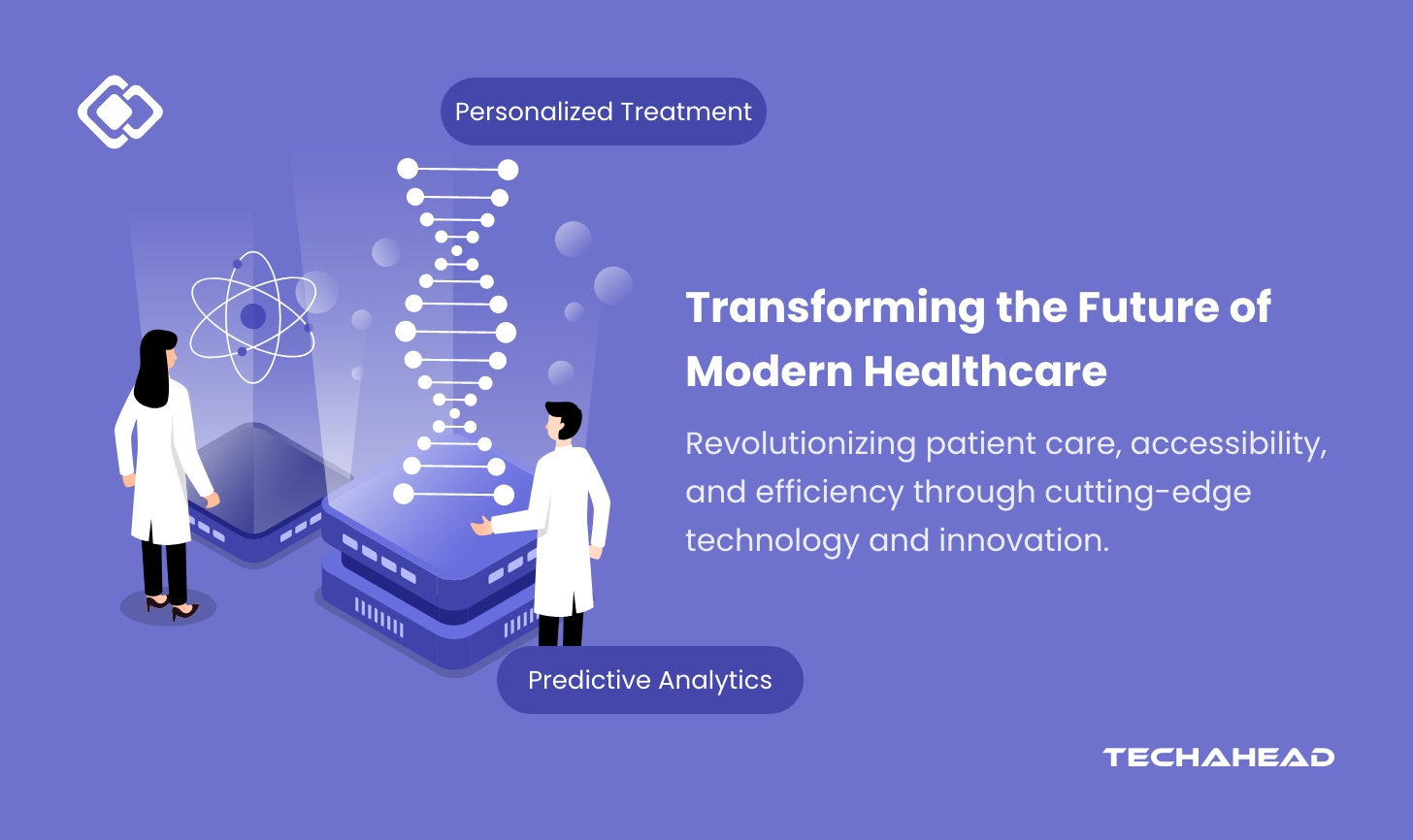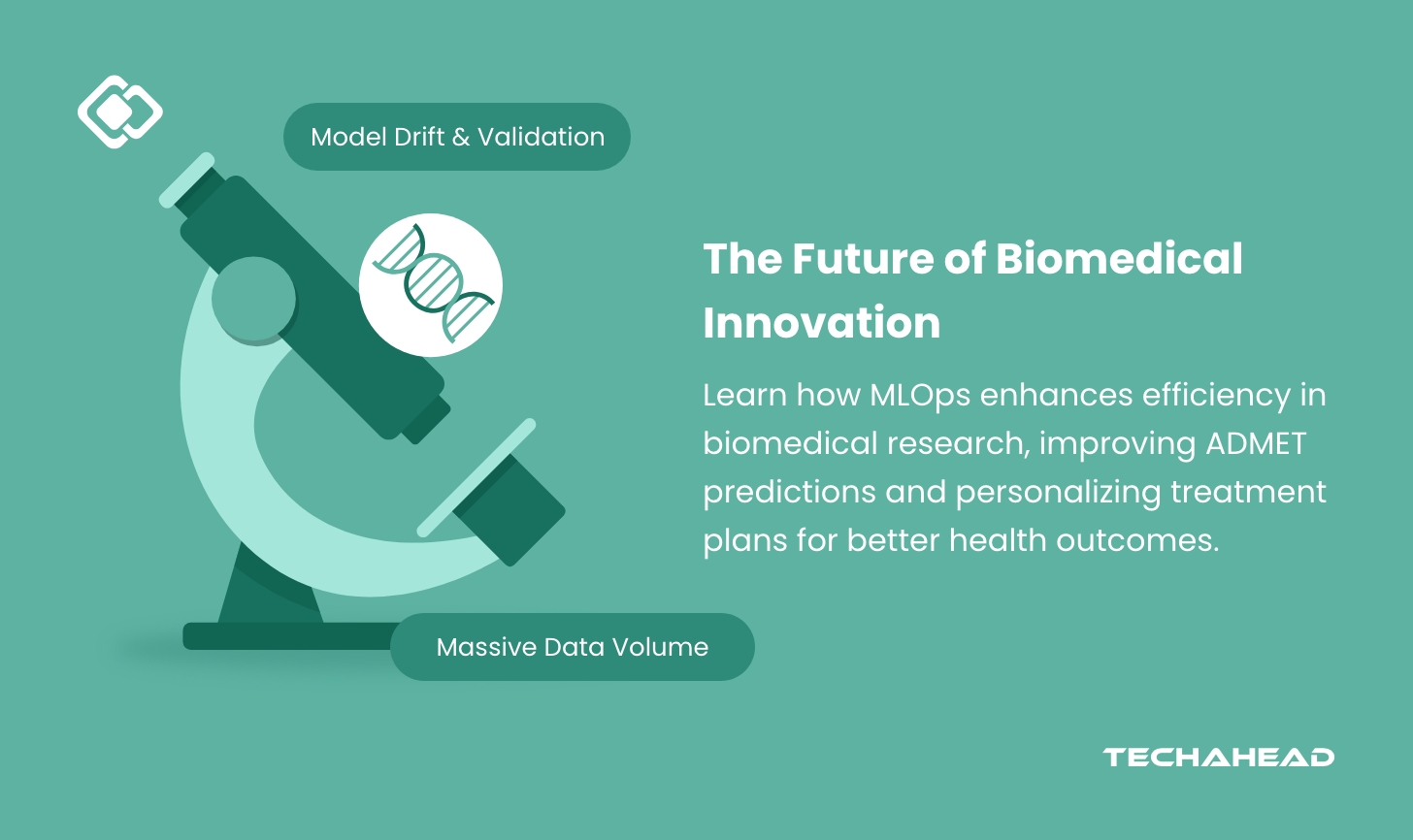
The integration of MLOps into biomedical research is composed to revolutionize the field, especially in drug discovery. The global MLOps market size was valued at USD 720.0 million in 2022 and is projected to grow from USD 1,064.4 million in 2023 to USD 13,321.8 million by 2030, exhibiting a CAGR of 43.5% during the forecast period.
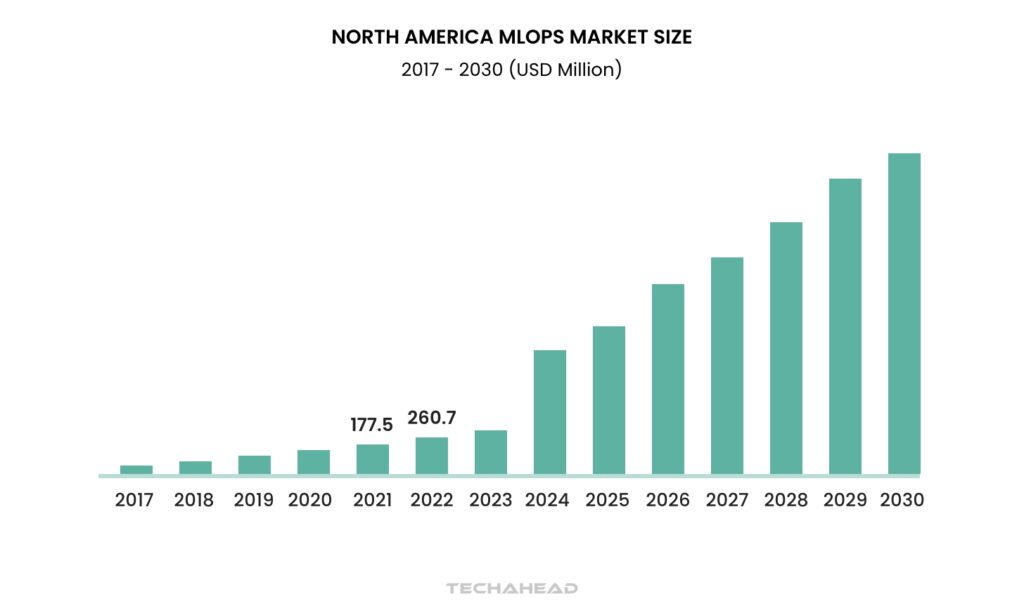
MLOps facilitate the development and deployment of machine learning models that are critical for predicting ADMET (Absorption, Distribution, Metabolism, Excretion, and Toxicity) properties of compounds, which are essential for identifying viable drug candidates and minimizing costly late-stage failures.
As researchers gradually rely more on data-driven approaches, MLOps guarantee that machine learning models are robust, scalable as well as reproducible. This is important not only for enhancing the accuracy of ADMET predictions but also for advancing personalized medicine—tailoring treatments based on individual patient data.
By stratifying patients according to genetic & phenotypic characteristics, MLOps enables more precise diagnoses and targeted therapies.
Moreover, MLOps streamlines the entire machine learning lifecycle—from data preparation to model monitoring—thereby improving operational efficiency in biomedical research. As the demand for timely and qualitative healthcare AI solutions intensifies, MLOps stands out as a transformative force that enhances predictive capabilities and accelerates insights, ultimately leading to improved patient outcomes.
In this blog, you will explore the multifaceted role of MLOps in biomedical research, highlighting its potential to reshape drug discovery and healthcare delivery in a rapidly evolving landscape.
Key Challenges in Biomedical Research Addressed by MLOps
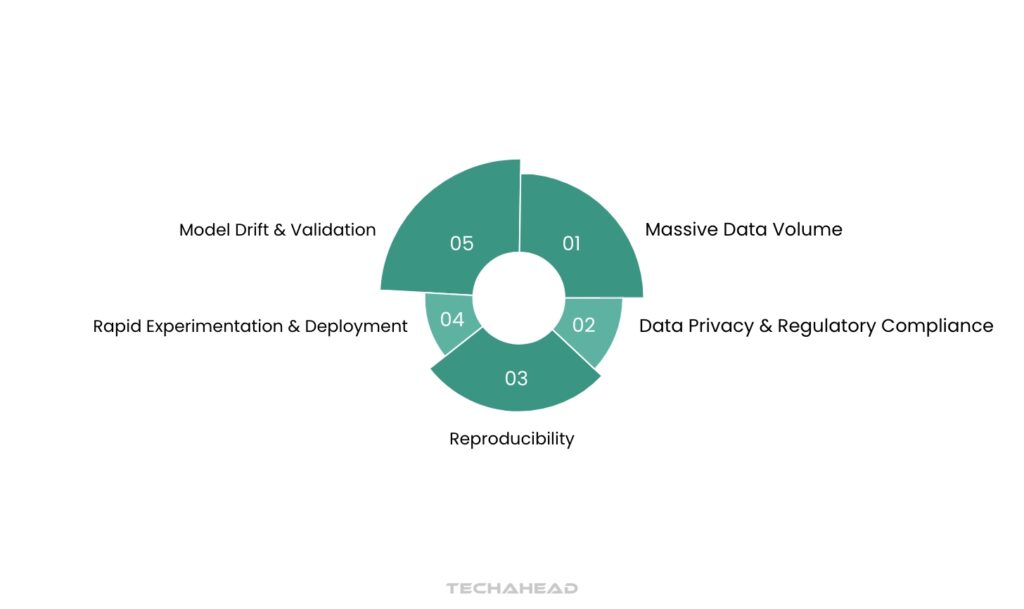
MLOps faces hurdles both in machine learning and traditional software development. Teams struggle with data quality, model tracking, deployment speed, and keeping systems running smoothly while meeting business goals and compliance requirements.
Massive data volume
Biomedical research generates petabytes of data daily, overwhelming traditional data management systems. MLOps addresses this challenge by offering robust data pipelines that can efficiently handle massive data influxes.
These pipelines ensure high data quality, accessibility, and organization, enabling researchers to manage and analyze vast datasets effectively. This capability is important for advancing biomedical research & improving patient outcomes in an increasingly data-driven environment.
Data privacy & regulatory compliance
The challenge of handling sensitive patient information in biomedical research necessitates rigorous security protocols and compliance with regulations. MLOps addresses this challenge by implementing sophisticated security measures, including audit trails and access controls, to safeguard sensitive data.
This enables researchers to collaborate effectively while ensuring that patient information remains protected and compliant with legal standards, ultimately fostering a secure environment for innovative research and development in healthcare.
Reproducibility
One significant challenge in biomedical research is the difficulty in replicating findings due to inconsistencies in experimental setups and analysis methods. MLOps addresses this issue by implementing version control for data and models, which creates detailed documentation of each research step.
This approach ensures transparency and reproducibility, allowing researchers to reliably validate their results and build upon previous work, ultimately enhancing the credibility of biomedical studies.
Rapid experimentation & deployment
Traditional research methods often suffer from significant delays, taking months or even years to transition from hypothesis to validated results. This slow pace can hinder the advancement of critical biomedical discoveries.
MLOps addresses this challenge by implementing automated testing and deployment pipelines, which accelerate the research process. By enabling rapid iteration while ensuring scientific rigor, MLOps allows researchers to efficiently refine their models and hypotheses, ultimately leading to faster and more reliable outcomes in drug discovery and development.
Model drift & validation
The rapid evolution of medical knowledge presents a significant challenge for biomedical researchers, as machine learning (ML) models must continuously adapt to new discoveries and shifting patient demographics. MLOps addresses this challenge by providing continuous monitoring and retraining capabilities, ensuring that these models remain accurate, relevant, and up-to-date.
This adaptability is crucial for maintaining the effectiveness of predictive analytics in drug discovery and personalized medicine, ultimately leading to improved patient outcomes in a dynamic healthcare landscape.
Benefits of Implementing MLOps in Biomedical Research
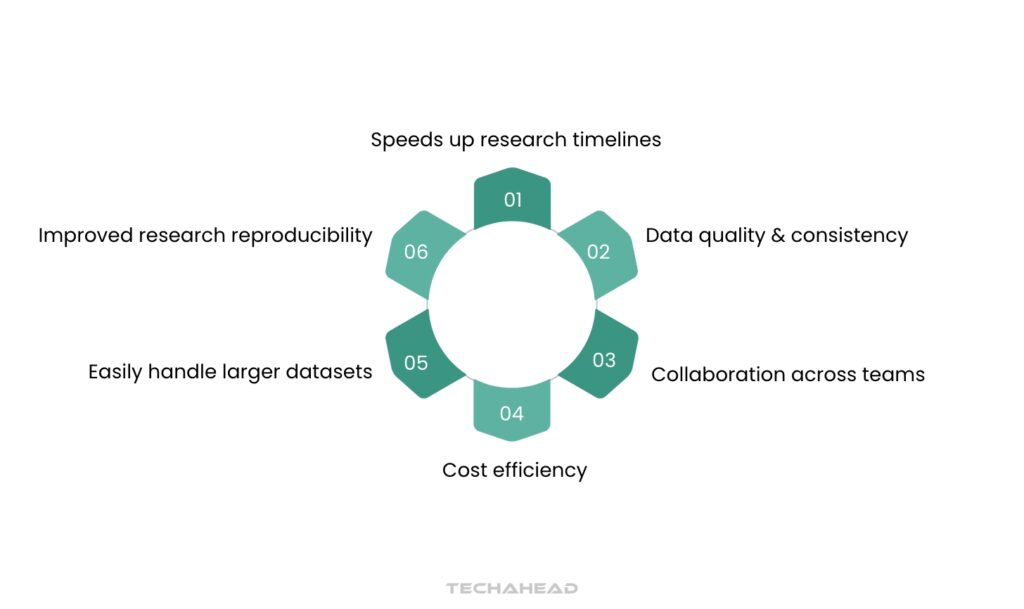
Implementing MLOps in biomedical research has transformed how we approach medical discoveries and handle healthcare data. Let’s explore the remarkable advantages this integration brings to the field.
Speeds up research timelines
First and foremost, MLOps dramatically speeds up research timelines. Gone are the days when researchers spent countless hours manually processing data and running experiments. With automated workflows, teams can now run multiple experiments simultaneously, analyze results faster, and move quickly from hypothesis to conclusion. This acceleration means potentially life-saving treatments can reach patients sooner.
Data quality & consistency
Data quality and consistency have seen massive improvements through MLOps adoption. In biomedical research, where even tiny errors can have serious consequences, MLOps provides strict data validation checks and standardized processing pipelines. This means fewer mistakes, more reliable results, and higher confidence in research findings. Imagine having a super-detailed quality control system that catches issues before they can affect your research outcomes.
Collaboration across teams
Collaboration across research teams has become seamless. MLOps creates a shared language and platform where scientists in different labs, or even different countries, can work together effectively. They can share models, replicate experiments, and build on each other’s work without the usual headaches of incompatible systems or lost information. It’s like having a universal research assistant that speaks everyone’s language.
Cost efficiency
Cost efficiency is another major win. By automating repetitive tasks and optimizing resource use, MLOps helps research institutions save both time & money. Equipment runs more efficiently, experiments waste fewer resources, and researchers can focus on creative problem-solving instead of routine maintenance.
Easily handle larger datasets
The ability to scale research operations has been transformed. MLOps lets teams easily handle larger datasets and more complex experiments without proportionally increasing their workload or risk of errors. When a promising research direction emerges, teams can quickly scale up their efforts without rebuilding their entire workflow.
Improved research reproducibility
Perhaps most importantly, MLOps has greatly improved research reproducibility – a longtime challenge in biomedical studies. Every step is tracked, every change is logged, and every decision is documented. This means other researchers can verify findings more easily, building trust in results and speeding up the overall pace of scientific discovery.
Real-world examples show dramatic improvements in research productivity. Labs using MLOps report completing studies in half the time while producing more reliable results. They’re able to tackle more complex questions and handle larger datasets with confidence.
Use Cases of MLOps in Biomedical Research
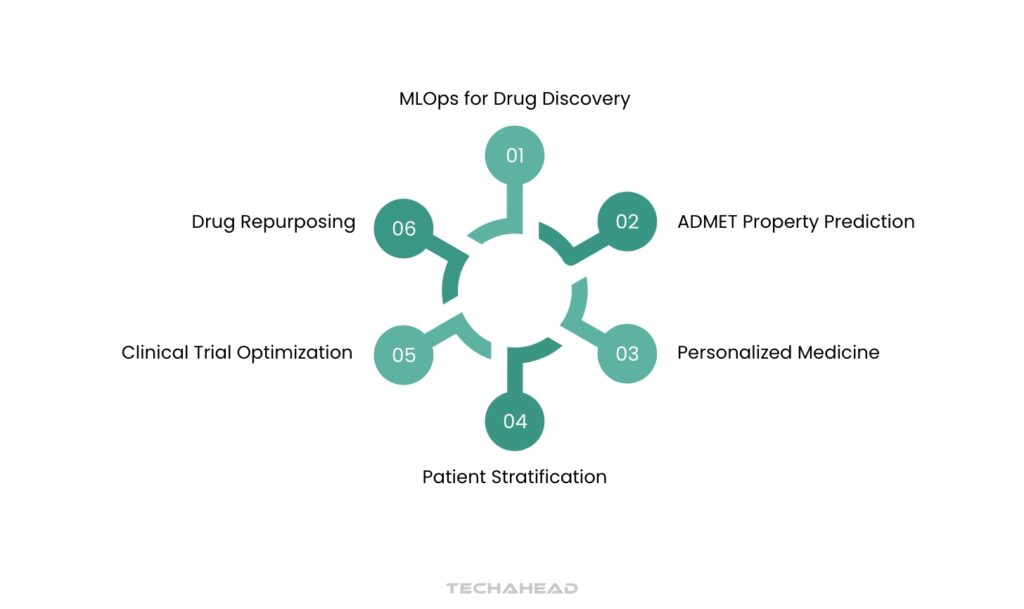
Looking forward, these benefits will only grow more significant. As biomedical research becomes increasingly data-driven and complex, having robust MLOps systems in place will be crucial for staying competitive and making meaningful discoveries.
It’s not just about doing research faster – it’s about doing better research that can more quickly translate into real benefits for patients. Now let’s talk about the use cases of MLOps in Biomedical Research.
MLOps for Drug Discovery
The pharmaceutical industry is increasingly adopting Machine Learning Operations (MLOps) to enhance drug discovery by analyzing extensive datasets of chemical compounds. By utilizing machine learning models, companies can identify promising drug combinations. MLOps tools facilitate continuous monitoring and retraining of these models as new data emerges, significantly reducing the time and costs involved in bringing new treatments to market.
Pfizer exemplifies this innovative approach by utilizing MLOps to accelerate drug discovery. The company employs machine learning to analyze molecular data and assess drug efficacy. With MLOps, Pfizer automates the retraining and testing of models whenever fresh data is available, which not only cuts down on development time but also enhances the efficiency of clinical trials.
ADMET Property Prediction
MLOps is essential for predicting ADMET (Absorption, Distribution, Metabolism, Excretion, and Toxicity) properties of compounds. Accurate predictions help assess drug candidates’ viability early in development. Continuous monitoring and retraining of models ensure they remain relevant as new data emerges, reducing costly failures later.
Personalized Medicine
MLOps advances personalized medicine by enabling the development of machine learning models that predict individual treatment responses based on patient-specific data. Analyzing genetic and clinical characteristics allows for tailored therapies, improving efficacy and minimizing adverse effects.
Patient Stratification
Effective diagnosis and treatment rely on stratifying patients based on various characteristics. MLOps allows researchers to group patients accurately using machine learning algorithms, supporting targeted treatment plans and enhancing disease management.
Clinical Trial Optimization
MLOps improves clinical trial efficiency by automating data analysis, MLOps in medical imaging analysis and model retraining. Machine learning models can predict enrollment rates and optimize trial designs, allowing real-time adjustments that lead to better outcomes.
Drug Repurposing
MLOps aids drug repurposing by analyzing existing drug datasets to discover new therapeutic uses. Machine learning algorithms can reveal hidden patterns, significantly reducing development time and costs compared to creating new drugs from scratch.
Tools & Technologies for MLOps in Biomedical Research

Building a robust MLOps infrastructure for biomedical research requires a diverse toolkit. Cloud platforms like AWS, Azure, and Google Cloud Platform (GCP) offer managed MLOps services, providing scalable compute, storage, and pre-built tools for model training, deployment, and monitoring. These platforms simplify infrastructure management and offer pay-as-you-go pricing, making them accessible to various research budgets.
For managing the machine learning lifecycle, tools like MLflow shine. MLflow helps track experiments, package code into reproducible runs, and deploy models to various platforms. Kubeflow, built on Kubernetes, offers a platform-agnostic way to deploy and manage machine learning workflows, especially valuable in complex research environments.
Data versioning tools like DVC (Data Version Control) and LakeFS are crucial for managing large datasets. These tools track changes to data, enabling researchers to reproduce experiments with specific data versions. This is essential in biomedical research where data integrity and traceability are paramount.
Containerization technologies like Docker and Kubernetes play a vital role in ensuring consistent model deployment across different environments. Docker packages models and their dependencies into containers, while Kubernetes orchestrates these containers, managing their deployment, scaling, and networking. This ensures models run reliably regardless of the underlying infrastructure.
These tools, combined with robust CI/CD pipelines, form the backbone of a modern MLOps setup in biomedical research. They enable automation, reproducibility, and efficient management of the entire machine learning lifecycle, accelerating discoveries and improving research outcomes.
The Future of MLOps in Biomedical Research
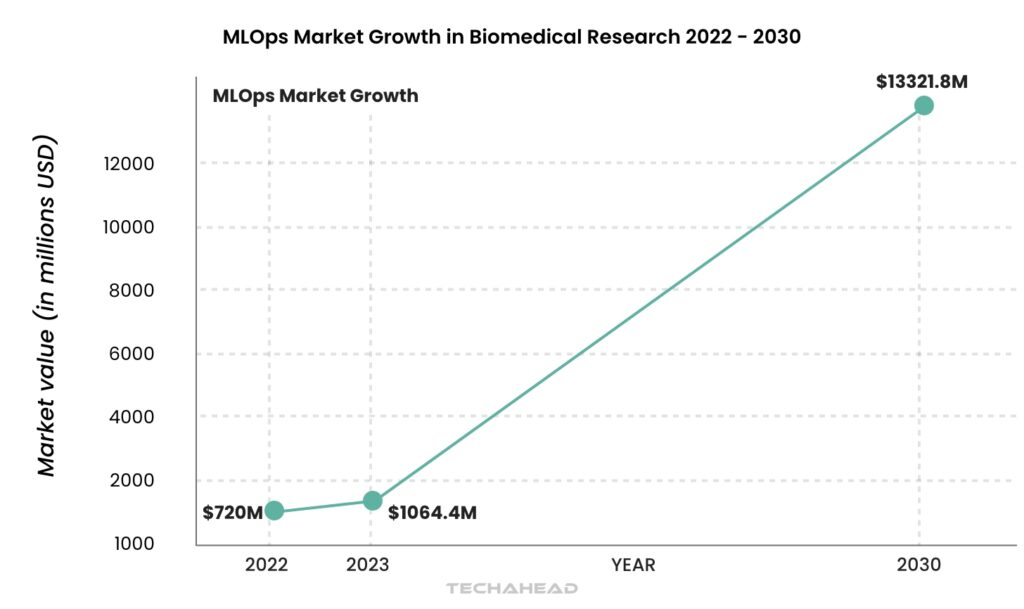
The explosive growth of MLOps in biomedical research tells a compelling story through its numbers. Starting at $720 million in 2022, the market has already leaped to $1,064.4 million in 2023, marking a remarkable year-over-year growth. But what’s truly eye-opening is the projected value of $13,321.8 million by 2030, representing a staggering compound annual growth rate (CAGR) of 43.5%.
To put this growth in perspective, the MLOps market is expanding faster than many high-growth tech sectors. The 43.5% CAGR means the market is essentially doubling every two years. Breaking down these numbers reveals an intriguing pattern: from 2022 to 2023 alone, the market grew by $344.4 million. This single-year jump represents nearly half of the entire 2022 market value, highlighting the accelerating adoption rate of MLOps in biomedical research.
Looking at the trajectory from 2023 to 2030, we’re talking about a twelve-fold increase over seven years. This means that for every $1 million invested in MLOps today, the market expects it to represent $12.5 million by 2030. Such exponential growth reflects the increasing recognition of MLOps as a crucial component in modern biomedical research infrastructure.
The numbers also tell a story about scale. Moving from $1,064.4 million to $13,321.8 million isn’t just about market value – it represents thousands of new research projects, hundreds of new institutions adopting MLOps practices, and potentially millions of patients benefiting from faster, more reliable research outcomes.
Breaking it down annually, we’re looking at an average increase of approximately $1,751 million each year between 2023 and 2030. This steady climb suggests sustained investment and adoption rather than a short-term boom. Each step up represents new technologies being developed, more researchers being trained, and more sophisticated systems being implemented.
These projections paint a picture of an industry on the cusp of mainstream adoption. The leap from millions to billions signals a transformation from specialized tools to essential infrastructure. With over $13 billion expected to flow into this sector by 2030, we’re likely to see innovations we can hardly imagine today, fundamentally changing how we approach biomedical data science research and, ultimately, healthcare itself.
Wrapping up
Machine learning operations offer a powerful solution to the data challenges in drug discovery. By automating tasks and ensuring data quality, MLOps frees researchers to focus on analysis and discovery. Combining high-quality data with MLOps can lead to faster drug discovery and improved healthcare outcomes. Tools like Elucidata’s Polly can further streamline the process for researchers by providing a centralized platform for data access and analysis. The future of drug discovery is bright with the combined power of MLOps and advanced biomedical data science.

FAQ
Model versioning is a crucial aspect of machine learning that allows researchers to track and manage different versions of trained models. This capability enables them to compare the performance of various iterations, ensuring that they can identify the most effective model for their specific needs. In addition, if a newer model underperforms or encounters issues, researchers can easily revert to a previous version, maintaining the integrity and reliability of their work. This systematic approach to version control enhances collaboration and efficiency in the research process, ultimately leading to better outcomes in biomedical applications.
Continuous Integration and Continuous Deployment (CI/CD) automates the processes of building, testing, and deploying machine learning models. This automation allows teams to iterate more quickly, facilitating faster release cycles. By streamlining these workflows, CI/CD enhances efficiency and ensures that models are consistently updated and delivered to production with minimal manual intervention.
MLOps is essential for accelerating the development of diagnostic tools, treatments, and vaccines during pandemics. By enabling rapid data analysis and swift model deployment, MLOps allows researchers to respond quickly to emerging health crises. This agility enhances the ability to analyze vast amounts of data, leading to timely innovations that can save lives and improve public health outcomes.

